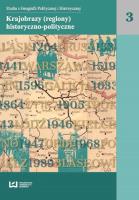Podlasie jako region pogranicza
Podlasie as the borderland region
Author(s): Marek BarwińskiSubject(s): Politics / Political Sciences, Geography, Regional studies
Published by: Wydawnictwo Uniwersytetu Łódzkiego
Keywords: Podlasie; pogranicze; geografia polityczna; mniejszości narodowe; Podlasie; borderland; political geography; ethnic minorities
Summary/Abstract: W artykule przedstawiono wieloaspektowy wymiar pełnienia przez Podlasie funkcji pogranicza politycznego, cywilizacyjnego, narodowościowego, wyznaniowego, języko-wego i kulturowego. Poza omówieniem cech i procesów typowych dla obszarów pograniczy oraz przedstawieniem historycznych, geograficznych i politycznych uwarunkowań uformowania się na Podlasiu szerokiej strefy zróżnicowanego pogranicza, poddano także analizie współczesne przemiany struktury etniczno-religijnej mieszkańców tego regionu oraz konsekwencje zmian sytuacji geopolitycznej (zwłaszcza w kontekście rozszerzenia Unii Europejskiej) dla postrzegania Podlasia w kategoriach regionu pogranicza. Podlasie, a historical and geographical region in eastern Poland, has been for centuries a political and national borderland where Polish, Lithuanian, Belorussian and Ukrainian ethnic elements intermingled. This resulted in a very durable ethnic, religious and cultural borderland in Podlasie. It was formed by a number of ethnic and religious communities that have inhabited this region since a remote past and influenced each other thus making the region a maze of nations, religions, languages and cultures. The ethnic and religious diversity of the region was determined by frequent changes in political linking of Podlasie and several waves of various settlers – a usual phenomenon in the region that was, particularly in the Middle Ages, a kind of frontier of Poland, Lithuania and Russia. Ethnic borderland in Podlasie is the most diversified region in Poland in respect of nationality, culture and religion. It forms both an interstate borderland between Poland and Belarus and an internal ethnic, religious, cultural and linguistic borderland. Predominent nations are Poles and Belorussians but the presence of Ukrainians, Lithuanians, Tatars, Romanies, Russians and Karaites, which makes the region a maze of nations. The religious mosaic is not so striking, nevertheless it is the only province of Poland where the Roman Catholics are outnumbered by followers of another religion, namely the Orthodox. The national and religious borderland in Podlasie is a zone with many transitory areas where different national, religious, linguistic and cultural groups overlap. There are hardly any clear dividing lines separating particular national and religious groups. In Podlasie various communities, in many cases closely related to each other, coexist side by side.Borderland zone are usually extensive areas where ethnic divisions tend to fade away. The whole area of north-eastern Poland, including Podlasie can be considered to be such a borderland zone. Here, several nationalities and religions are separated by more or less vast transitory belts rather than definite dividing lines. Sometimes such transitory areas gave rise to some new derivative communities.
Journal: Studia z Geografii Politycznej i Historycznej
- Issue Year: 2014
- Issue No: 03
- Page Range: 281-306
- Page Count: 26
- Language: Polish

